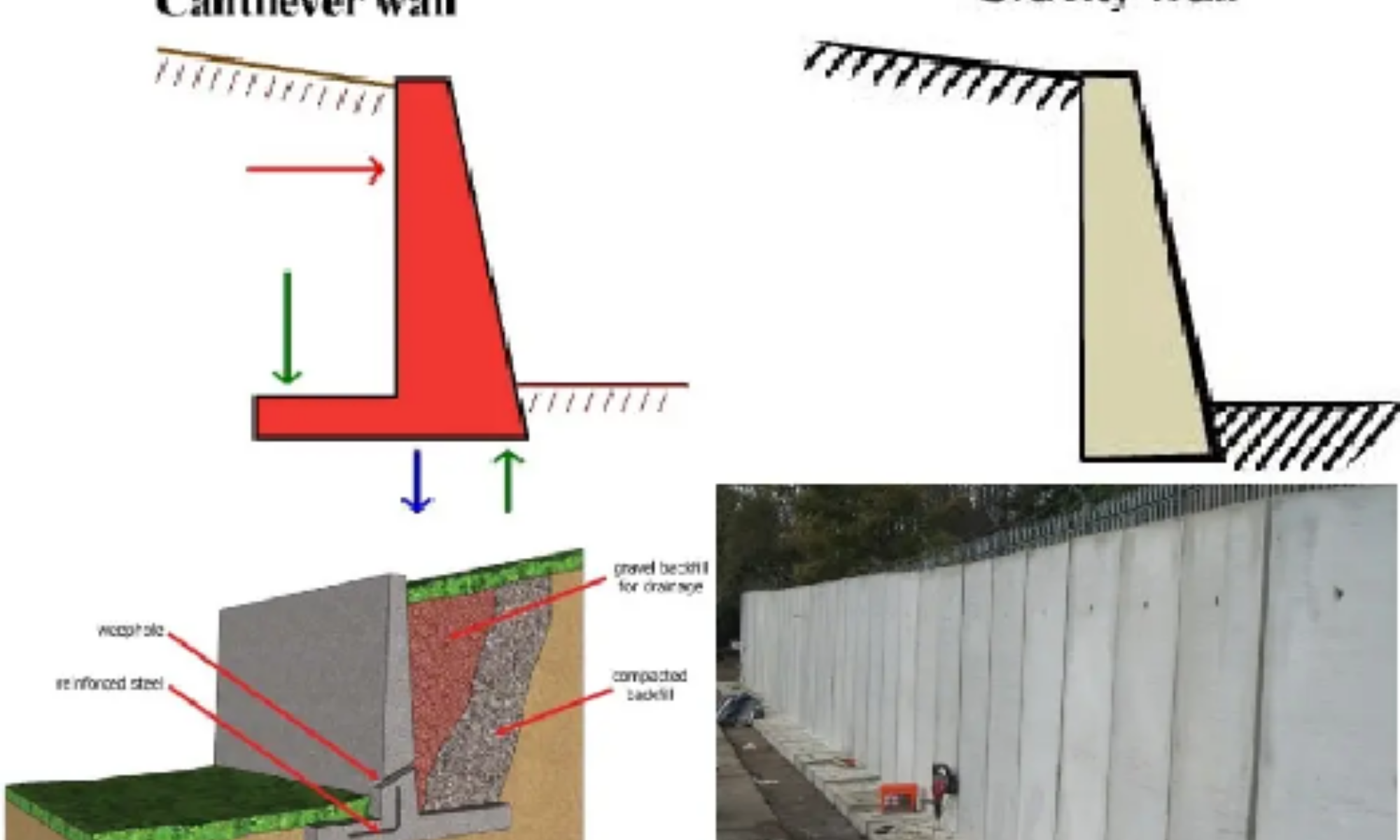Design of Retaining Walls
[edit] Introduction
What a time to be alive! Retaining walls are more than just a practical way to keep soil, water, and even certain building materials from spilling into your outdoor space. Nowadays, these structures can be designed in a variety of ways to provide a pleasant aesthetic to your outdoor space and cleverly manage the land around you. From terracing to environmentally-friendly designs, there’s no limit to the wonders of a retaining wall. Let’s dive into the world of retaining walls and explore the possibilities of this powerful tool.
[edit] Building blocks of retaining walls
Retaining walls have been used for centuries, and with the right materials, they can be built to last. Structural and decorative blocks, precast concrete, poured concrete, timber, and boulders are all popular materials used to construct retaining walls. The particular material used depends on the site, the depth of the wall, and the desired design. With hundreds of options for materials and shapes, the possibilities for a retaining wall are endless.
[edit] Construct retaining walls with creativity
A retaining wall can be used to create a stunning backdrop for your outdoor space. Instead of a flat, dull retaining wall, consider opting for a dramatic shape to create interest. A curved wall can soften a hard-scape, while a terraced wall can draw attention to the texture and height of your outdoor space. With the right materials and creative ideas, a retaining wall can add a unique touch to your outdoor area.
[edit] Harnessing the power of terracing
Terracing is a great way to transform a sloped garden into a beautiful outdoor area. By creating multiple levels, a retaining wall can be utilised to hold soil in place and create a flat surface for landscaping. With terracing, you can break up a steep slope into manageable stair-like sections. This allows you to create different levels of planting beds, gardens, and even seating areas.
[edit] Creative ways to design retaining walls
Retaining walls can be designed to match the natural surroundings, such as a rustic wood wall that blends in with the trees and plants. Alternatively, you can opt for a modern design to stand out from the rest of the outdoor area. An artistic wall with intricate patterns and different levels of brickwork can be used to create a structure that stands out from the rest.
[edit] Bending the laws of gravity with retaining wall
Retaining walls are a great way to manage the flow of runoff water, redirect soil erosion, and even prevent land slippage. Often, these walls are built with a slight incline to help ensure that the soil doesn’t build up against the wall. This angled design helps prevent the wall from toppling over due to the weight of the soil.
[edit] Crafting walls for every setting
These days, there are an array of wall materials to choose from. From concrete blocks and poured concrete to stone, timber, and even bricks, the options are endless. Depending on the environment and the desired aesthetic, you can choose the right material to craft the perfect retaining wall.
[edit] Ideas for ecologically-minded retaining walls
If you’re looking for a more environmentally-friendly option, consider constructing a living wall. This type of retaining wall is built with natural materials such as plants, soil, and stones that can help promote a healthy, sustainable ecosystem. Not only are these walls aesthetically pleasing, but they also provide a natural way to protect your outdoor space from the elements.
[edit] Constructive options for your outdoor space
If you’re looking to make a statement with your retaining wall, consider combining different materials. This can be a great way to create a unique look that stands out from the rest of your outdoor space. Utilising different shapes, sizes, and colours can help create a one-of-a-kind design that will be the envy of your neighbourhood.
[edit] Strategies for reinforcing retaining walls
Retaining walls need to be reinforced to bear the weight of the soil and other materials. To do this, you will need to use steel bars, anchors, and other reinforcement materials to ensure the stability of the wall. It’s important to consult a professional to ensure that your wall is properly reinforced for the weight that it’s supporting.
[edit] Engineering a lasting retaining wall
Retaining walls need to be installed in the right way to ensure that they last for years to come. The right drainage system, water management, and soil compaction are all important factors that need to be taken into consideration when constructing a retaining wall. Consulting with a professional engineer or landscaper can help ensure that your retaining wall is built to last.
[edit] Aesthetically pleasing retaining wall designs
With the right materials, a retaining wall can be designed to bring a unique style to your outdoor space. Consider using mortar between the blocks to create a seamless look, or go for a more rustic look with stone walls. The options are endless!
[edit] Retaining walls are here to stay!
Retaining walls are an essential part of our outdoor space, and are here to stay for years to come. Whether you’re looking for a simple way to keep water from pooling in an area, or something more aesthetically pleasing for your outdoor area, these structures can be designed and built to meet any need. With the right materials and design, a retaining wall can be a beautiful addition to your outdoor space.
[edit] Related articles on Designing Buildings
- Caisson.
- Coastal defences.
- Cofferdam.
- Continuous flight auger piles.
- Diaphragm wall.
- Driven piles.
- Foundations.
- Groundworks.
- Ground anchor.
- Grouting in civil engineering.
- Hesco barrier.
- Micropiles.
- Pile foundations.
- Pile wall.
- Prestressed concrete.
- Preventing wall collapse.
- Retaining walls.
- Sheet piles.
- Shoring.
- Sleeper wall.
- Soil nailing.
- Structural engineer.
- Temporary works.
- Underpinning.
- Vibro-compaction.
- Vibro-replacement.
Featured articles and news
RTPI leader to become new CIOB Chief Executive Officer
Dr Victoria Hills MRTPI, FICE to take over after Caroline Gumble’s departure.
Social and affordable housing, a long term plan for delivery
The “Delivering a Decade of Renewal for Social and Affordable Housing” strategy sets out future path.
A change to adoptive architecture
Effects of global weather warming on architectural detailing, material choice and human interaction.
The proposed publicly owned and backed subsidiary of Homes England, to facilitate new homes.
How big is the problem and what can we do to mitigate the effects?
Overheating guidance and tools for building designers
A number of cool guides to help with the heat.
The UK's Modern Industrial Strategy: A 10 year plan
Previous consultation criticism, current key elements and general support with some persisting reservations.
Building Safety Regulator reforms
New roles, new staff and a new fast track service pave the way for a single construction regulator.
Architectural Technologist CPDs and Communications
CIAT CPD… and how you can do it!
Cooling centres and cool spaces
Managing extreme heat in cities by directing the public to places for heat stress relief and water sources.
Winter gardens: A brief history and warm variations
Extending the season with glass in different forms and terms.
Restoring Great Yarmouth's Winter Gardens
Transforming one of the least sustainable constructions imaginable.
Construction Skills Mission Board launch sector drive
Newly formed government and industry collaboration set strategy for recruiting an additional 100,000 construction workers a year.
New Architects Code comes into effect in September 2025
ARB Architects Code of Conduct and Practice available with ongoing consultation regarding guidance.
Welsh Skills Body (Medr) launches ambitious plan
The new skills body brings together funding and regulation of tertiary education and research for the devolved nation.
Paul Gandy FCIOB announced as next CIOB President
Former Tilbury Douglas CEO takes helm.
UK Infrastructure: A 10 Year Strategy. In brief with reactions
With the National Infrastructure and Service Transformation Authority (NISTA).

























